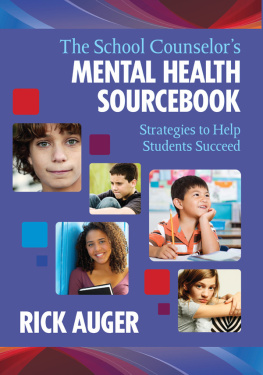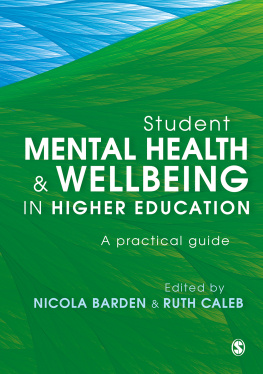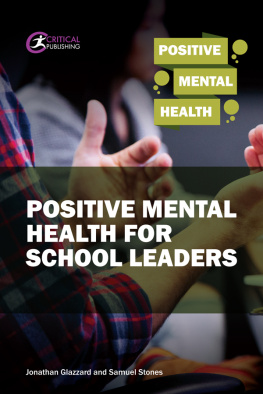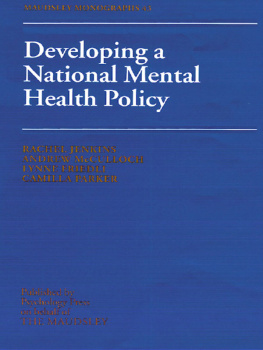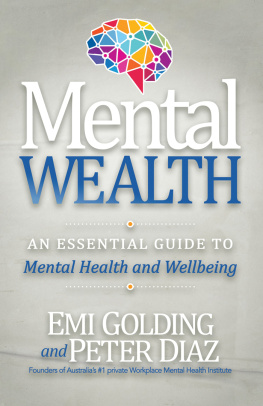
The MENTAL HEALTH
and WELLBEING
HANDBOOK for Schools
Transforming Mental Health
Support on a Budget
Clare Erasmus
Foreword by Chris Edwards

Jessica Kingsley Publishers
London and Philadelphia
Contents
Foreword
By Chris Edwards
Back in the halcyon days of the English Language IGCSE days, when working as a deputy head and part-time English teacher, I used to have the dubious honour of being the assessor for the speaking and listening assessments for a cohort of 250 Year 11 students. This involved each being allocated a 10 minute slot, where they would talk for 34 minutes on a topic of their choice, whilst I hastily constructed a series of questions to occupy the final 67 minutes of our time together. As youd expect, many students chose to talk about sport, a passion I share, which enabled me to sail through the Q&A with impressive panache. This wasnt the case with some of the outliers, however, whose chosen subjects included dragons, rollercoaster mechanics and Kim Kardashian, amongst other niche interests.
Concerningly though, the most striking aspect of this experience was the number of students who chose to talk about the pressures of being a teenager in this age of technology. I was absolutely aghast at the trepidation that these youngsters described in the build up to posting something as innocent as a photograph of themselves online. The number who spent hours using apps to modify their looks, terrified that someone would notice a blemish which could be mocked, was incredible. Many talked about the pressure to gain likes to demonstrate popularity and the absolutely relentless, 24/7 urge to stay connected to social media for fear of missing out.
Shortly after the aforementioned assessment period came exam time. A young lady who I was mentoring absolutely flew through her English exam, which delighted me, but when it came to the time to go into her other exams, she froze, crippled with anxiety and couldnt step over the threshold into the exam hall. On speaking to her later, she explained that she had felt no fear in English as 60% of the final grade had already been acquired, but the linear exams, which would represent 100% of the fruits of 11 years of labor, were too much for her to bear.
I promised myself at that moment that I would do my utmost to prevent anything like that happening again. It really affected me, and I felt that I had let her down by not spotting the severity of her anxiety and putting things into place to help her. Furthermore, I felt angry that not enough had been done to prevent her reaching that level of angst, in the years building up to this terminal stage of compulsory school life.
Like many who were trained in my generation of teachers, mental wellbeing was never mentioned in our formative years in the profession, so I didnt know where to start. Needing a team around me to try to start building, I approached Clare, who jumped at the chance to grow such an important strategy. I also showed my commitment to the cause by marrying the daughter of Rita Rebholz, a wonderful lady who has a doctorate in adolescent mental wellbeing, which was a costly but vital development.
If you are starting this journey as a Head or senior leader, be aware that, as the modern saying goes, There will be haters. Id expect there to be a minority of people in any establishment who are blissfully unaware of Abraham Lincolns Melancholy or Winston Churchills Black Dog, believing that anyone claiming any form or mental illness simply needs to man up and stop being a snowflake. In fact, one of my biggest regrets was not speaking up when a former leadership colleague derided a child for refusing to leave his bedroom for an exam due to his apparently crippling anxiety.
However, it is exceptionally rare to conceive a strategy where every member of staff is on board from the outset. Sometimes, as a leader, you need to accept that it may take a while for the laggards to hop on board but be assured: they will. They will, because they will realise the urgency of giving some sort of support to our young people who need it so desperately. I was once told on Twitter by a teacher, hiding behind a pseudonym and a profile picture of a cartoon character (as so many seem to), that the idea that teachers should be involved in mental wellbeing provision is absurd. Now, whatever your thoughts on the lack of external funding to support schools in this domain, refusing to engage in any sort of pre-emptive work to support your students positive mental wellbeing seems quite contrary to the very reason most of us join the profession.
It is likely that fear plays a large part in the protests. But I have found that using Dr. Rebholzs analogy of a continuum from 0-10, (with 0 being perfect mental wellbeing and 10 being full mental breakdown) very useful in explaining that it is our job to keep students below a level 5, where we would expect the real experts to become involved. Nobody is saying that we are trained health professionals, but we do have a duty to guide students towards choices and behaviors which positively affect their mental or physical health.
What Clare is able to get across in this book, in her own inimitable style, is how to go about the daunting prospect of setting up a whole school strategy in this critical area. She will not claim to have resolved the worlds problems in the field of youth mental health and wellbeing, but her pioneering work is inspirational, as well as being absolutely replicable. Every step of the journey is broken down in the finest of details and this book should be read by anyone who has responsibility for leading any sort of educational establishment. Together, we can create a real movement to benefit our youngsters and there can be no better place to start than the pages which follow these words.
Preface
This book was written in response to the multitude of emails and messages I received from teachers, teaching assistants, headteachers and parents seeking advice on how to support the mental wellbeing of young people in a school setting. What they all had in common was very little or no budget and a sense of feeling overwhelmed and not knowing where to start. I have written it as a user-friendly handbook to accompany any teacher or designated lead on mental wellbeing, with a micro budget, starting out on the road to support the mental wellbeing of their students.
When I started blogging three years ago, there were limited resources and not much advice for school teachers, but in the space of three years an incredible wealth of information has become available. I have written candidly of my own imposter syndrome and hope that my anecdotes and approaches will help build the confidence of the teacher in realising they really are the best person to have that first conversation with a young person when the worrying signs are spotted.
The book was completed just after the UK Government released in July 2018 its Government Response to the Consultation on Transforming Children and Young Peoples Mental Health Provision: A Green Paper and Next Steps. On reading the consultation and the UK governments response, I found some key positive messages:
The plan is to have a mental health lead in every school and college by 2025.
Mental health support teams will be created, and trained staff will be linked to groups of schools and colleges. They will offer individual and group help to young people with mild to moderate mental health issues, including anxiety, low mood and behavioural difficulties.
The UK Government wants to reduce the time it takes to get treatment from children and young peoples mental health services.
Next page


